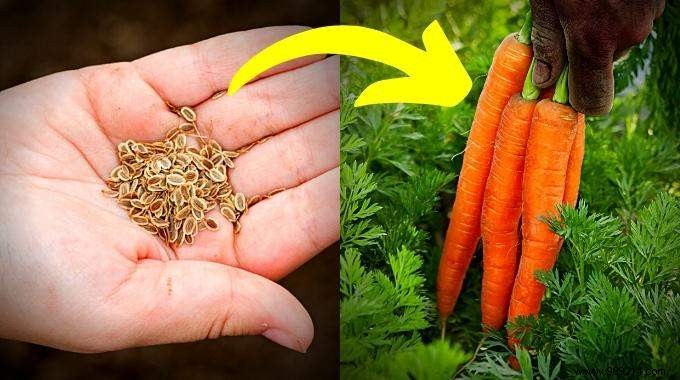
How about growing carrots in your vegetable patch?
And this, at any time of the year?
Well, it's possible!
Carrots are very easy to grow.
They just need a temperature between 7° and 29°C.
Suffice to say that they can be grown everywhere and even in winter in greenhouses.
In less than 2 months, you harvest your first carrots!
Here is how to grow beautiful carrots at home all year round in just 5 easy steps . Watch:

Choose early or early varieties like:
- the "Amsterdam" (grows in 55 days)
- "Chantenay à coeur rouge" (grows in 70 days)
- "Nantaise" (grows in 70 days)
- "Nantes Touchon" (grows in 65 days)
- the "Presto" (grows in 50 days).
Be aware that sand carrots germinate slowly and need protection in cold weather.
Also protect seedlings from birds and heavy rain with burlap .
If the temperature drops below 5°C or if it freezes, put the carrot seedlings in a greenhouse to germinate them.
Carrots are difficult to transplant, so sow them directly in the right place.
And keep the place moist to promote rapid germination and steady growth.

Carrots love sandy soil!
If this is what you have in your vegetable garden, just remove the stones to start sowing.
Next, prepare a small raised mound of soil.
And turn the earth with the pitchfork.
Remember to break up the clods.
If your soil is clay, that's another story.
Add sand and compost to loosen it.
Sprinkle the soil with a natural fertilizer rich in phosphorus which promotes the growth of carrots. For example, wood ash, coffee grounds or fishbone or seaweed meal.
But do not add manure that contains nitrogen because it promotes the development of leaves and not roots.
Water the soil evenly and deeply and let it rest for a day or two before sowing the carrots.
By the way, did you know that you can plant carrots in tubs on the terrace or balcony?
Can we grow them indoors? Yes, provided it's not too hot where you live.

Since carrot seeds are tiny, it is very easy to sow too many of them.
To avoid this, mix seeds with sand in the palm of your hand.
It makes sowing easier and you will know exactly where the seeds have been deposited.
The other solution is to use a paper tape.
This is the best way to evenly space carrot seeds.
This avoids having to thin the seedlings later.
With a rake or a small hoe, dig a furrow 2 cm deep.
Space each row about 30 cm apart.
Then, sow the seeds every 2.5 cm on the small mound you have prepared.
This allows water to pass between the different mounds and leave the soil moist.
After sowing, lightly cover the seeds with moss, peat or potting soil for 0.5 cm.
Finally, lightly tamp the soil with the palm of your hand.
Why?
This allows the seeds to have good contact with the soil, which is essential for germination.

As we have just seen, carrot seeds are not sown deep.
They must therefore be well protected from heavy rain.
To do this, use a protective veil like this one.
When the weather is hot and dry, use burlap strips to cover planting rows.
Consider moistening the burlap to keep the seedlings moist until the seeds germinate.
Monitor, lifting the canvas every 2 days.
When the seeds have germinated, remove the burlap.
If temperatures drop below 7°C, also protect the seeds.
How? 'Or' What ? By putting the hessian or a plastic sheet so as to create a "greenhouse effect".

It is important to keep the soil moist until the seeds germinate.
During the first 2 weeks, wet the soil, once or twice a day with a spray.
Don't let the soil dry out.
Once the carrots have sprouted, continue moistening the soil with the spray until they are well rooted.
Maintain soil moisture regularly.
Why ? Because the roots use water as a path to go deeper and grow.
When the roots begin to grow well, watering is not as necessary. Because the roots are able to draw what they need from deep.
But, if the green leaves start to wilt, it means you need to water.
By the way, if the soil is dry for more than 7 cm, it's also really time to water.
Eliminate weeds from carrot beds as well.
Indeed, they compete with carrots and rob them of moisture and growing space.

The last step is simple but important.
Baby carrots should be spaced 2.5 cm apart.
Why ? That way, they can grow without the roots getting in the way.
If they are too close together, thin the row.
This means that you can remove the excess carrots.
Cut off the buds at ground level with scissors before the roots develop.
You can eat the tops you removed in a salad.
Carrots are ready to harvest when you see a big red crown emerging from the ground.
Afterwards, it's up to you to see if you want to wait for them to get bigger.
But new carrots can be eaten in a salad.
They are also sweet enough to be eaten as soon as they are at least 4 cm in diameter.
To harvest them, remove the soil around the crown of the carrots, then pull them.
My advice: sow various varieties of carrots. There are excellent ones with pretty purple, yellow or white colors!
As they don't all mature at the same time, you can harvest them throughout the summer.
- Remember to practice crop rotation. That is, you should avoid replanting carrots on the same plot for 3 or 4 years.
- When to plant them? For summer crops, sow in March/April. For autumn harvests, sow in May/June.